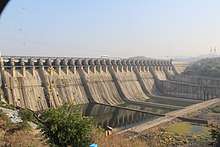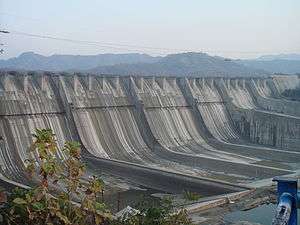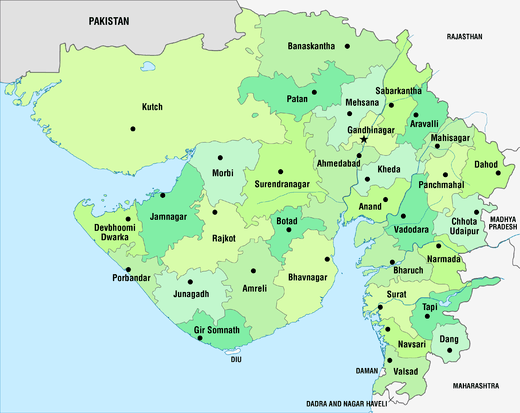Sardar Sarovar Dam
| Sardar Sarovar Dam | |
|---|---|
 The Sardar Sarovar Dam on Narmada River (Also called Gujarat's Lifeline ) | |
 Location of Sardar Sarovar Dam in Gujarat | |
| Country | India |
| Location | Navagam, wardha, India |
| Coordinates | 21°49′49″N 73°44′50″E / 21.83028°N 73.74722°ECoordinates: 21°49′49″N 73°44′50″E / 21.83028°N 73.74722°E |
| Status | Operational |
| Construction began | April, 1987 |
| Opening date | 17 September, 2017 |
| Owner(s) | Narmada Control Authority |
| Dam and spillways | |
| Type of dam | gravity dam, concrete |
| Impounds | Narmada River |
| Height | 138.68 meters |
| Height (foundation) | 163 m (535 ft) |
| Length | 1,210 m (3,970 ft) |
| Spillway capacity | 84,949 m3/s (2,999,900 cu ft/s) |
| Reservoir | |
| Total capacity | 9.5 km3 (7,700,000 acre⋅ft) |
| Active capacity | 5.8 km3 (4,700,000 acre⋅ft) |
| Catchment area | 88,000 km2 (34,000 sq mi) |
| Surface area | 375.33 km2 (144.92 sq mi) |
| Maximum length | 214 km (133 mi) |
| Maximum width | 1.77 km (1.10 mi) |
| Maximum water depth | 140m |
| Normal elevation | 138 m (453 ft) |
| Power Station | |
| Operator(s) | Sardar Sarovar Narmada Nigam Limited[1] |
| Commission date | June 2006 |
| Turbines |
Dam: 6 x 200 MW Francis pump-turbine Canal: 5 x 50 MW Kaplan-type[2] |
| Installed capacity | 1,450 MW [1 Billion kWh every year] |
|
Website www | |

The Sardar Sarovar Dam is a gravity dam on the Narmada river near Navagam, Gujarat in India. Four Indian states, Gujarat, Madhya Pradesh, Maharastra and Rajasthan, receive water and electricity supplied from the dam. The foundation stone of the project was laid out by Prime Minister Jawaharlal Nehru on April 5, 1961. The project took form in 1979 as part of a development scheme to increase irrigation and produce hydroelectricity. The dam was inaugurated by Prime Minister Modi on September 17, 2017.[3]
One of the 30 dams planned on river Narmada, Sardar Sarovar Dam (SSD) is the largest structure to be built. It is one of the largest dams in the world.[4][5] It is a part of the Narmada Valley Project, a large hydraulic engineering project involving the construction of a series of large irrigation and hydroelectric multi-purpose dams on the Narmada river. Following a number of controversial cases before the Supreme Court of India (1999, 2000, 2003), by 2014 the Narmada Control Authority had approved a series of changes in the final height – and the associated displacement caused by the increased reservoir, from the original 80 m (260 ft) to a final 163 m (535 ft) from foundation.[6][7] The project will irrigate more than 18,000 km2 (6,900 sq mi), most of it in drought prone areas of Kutch and Saurashtra.
The dam's main power plant houses six 200 MW Francis pump-turbines to generate electricity and include a pumped-storage capability. Additionally, a power plant on the intake for the main canal contains five 50 MW Kaplan turbine-generators. The total installed capacity of the power facilities is 1,450 MW.
Geographical Location
To the south west Malwa plateau, the dissected hill tracts culminate in the Mathwar hills, located in Alirajpur district of Madhya Pradesh. Below these hills Narmada river flows through a long, terrific gorge. This gorge extends into Gujarat where the river is tapped by the Sardar Sarovar dam.
Narmada Canal
The dam irrigate 17,920 km2 (6,920 sq mi) of land spread over 12 districts, 62 talukas, and 3,393 villages (75% of which is drought-prone areas) in Gujarat and 730 km2 (280 sq mi) in the arid areas of Barmer and Jalore districts of Rajasthan. The dam also provide flood protection to riverine reaches measuring 30,000 ha (74,000 acres) covering 210 villages and Bharuch city and a population of 400,000 in Gujarat.[8] Saurastra Narmada Avataran Irrigation is a major program to help irrigate a lot of regions using the canal's water.
Solar Power Generation
In 2011, the government of Gujarat announced plans to generate solar power by placing solar panels over the canal, making it beneficial for the surrounding villages to get power and also help to reduce the evaporation of water. The first phase consists of placing panels along a 25 km length of canal, with capacity for up to 25 MW of power.[9]
Controversy
The dam is one of India's most controversial, and its environmental impact and net costs and benefits are widely debated. The World Bank was initially funding SSD, but withdrew in 1994. The Narmada Dam has been the centre of controversy and protest since the late 1980s.[10]
One such protest takes centre stage in the Spanner Films documentary Drowned Out (2002), which follows one tribal family who decide to stay at home and drown rather than make way for the Narmada Dam.[11] An earlier documentary film is called A Narmada Diary (1995) by Anand Patwardhan and Simantini Dhuru. The efforts of Narmada Bachao Andolan ("Save Narmada Movement") to seek "social and environmental justice" for those most directly affected by the Sardar Sarover Dam construction feature prominently in this film. It received the (Filmfare Award for Best Documentary-1996).[12]
The figurehead of much of the protest is Medha Patkar, the leader of the NBA[13] The movement was cemented in 1989, and received the Right Livelihood Award in 1991.[14]
Support for the protests also came from Indian author Arundhati Roy, who wrote "The Greater Common Good", an essay reprinted in her book The Cost of Living, in protest of the Narmada Dam Project.[15] In the essay, Roy states:
Big Dams are to a Nation's "Development" what Nuclear Bombs are to its Military Arsenal. They are both weapons of mass destruction. They're both weapons Governments use to control their own people. Both Twentieth Century emblems that mark a point in time when human intelligence has outstripped its own instinct for survival. They're both malignant indications of civilisation turning upon itself. They represent the severing of the link, not just the link—the understanding—between human beings and the planet they live on. They scramble the intelligence that connects eggs to hens, milk to cows, food to forests, water to rivers, air to life and the earth to human existence.
Height increases

undergoing height increase in 2006.
- In February 1999, the Supreme Court of India gave the go ahead for the dam's height to be raised to 88 m (289 ft) from the initial 80 m (260 ft).
- In October 2000 again, in a 2-to-1 majority judgment in the Supreme Court, the government was allowed to construct the dam up to 90 m (300 ft).[6]
- In May 2002, the Narmada Control Authority approved increasing the height of the dam to 95 m (312 ft).
- In March 2004, the Authority allowed a 15 m (49 ft) height increase to 110 m (360 ft).
- In March 2006, the Narmada Control Authority gave clearance for the height of the dam to be increased from 110.64 m (363.0 ft) to 121.92 m (400.0 ft). This came after 2003 when the Supreme Court of India refused allow the height of the dam to increase again.
- In August 2013, heavy rains raised the reservoir level to 131.5 m (431 ft), which forced 7,000 villagers upstream along the Narmada River to relocate.[16]
- On June 2014, Narmada Control Authority gave the final clearance to raise the height from 121.92 m (400.0 ft) metres to 138.68 m (455.0 ft)[17]
- The Narmada Control Authority decided on June 17 2017 to raise the height of the Sardar Sarovar Dam to its fullest height 163 meter by ordering the closure of 30 Gates
Report of the Ministry of Environment and Forests (MoEF)
The Second Interim Report of the Experts' Committee set up by the Ministry of Environment and Forests (MoEF) of the Government of India to assess the planning and implementation of environmental safeguards with respect to the Sardar Sarovar (SSP) and Indira Sagar projects (ISP) on the Narmada River. The report covers the status of compliances on catchment area treatment (CAT), flora and fauna and carrying capacity upstream, command area development (CAD), compensatory afforestation and human health aspects in project impact areas. Construction, on the other hand, has been proceeding apace: the ISP is complete and the SSP nearing completion. The report recommends that no further reservoir-filling be done at either SSP or ISP; that no further work be done on canal construction; and that even irrigation from the existing network be stopped forthwith until failures of compliance on the various environmental parameters have been fully remedied.[18]
The Supreme Court decision
Despite popular protest, the Supreme Court gave clearance for the height to be increased to 121.92 m (400 ft), but in the same judgment Justice Mr. Bharucha gave directions to Madhya Pradesh and Maharashtra (the Grievance Redressal Authorities of Gujarat) that before further construction begins, they should certify (after inspection) that all those displaced by the raise in height of 5 metres have already been satisfactorily rehabilitated, and also that suitable vacant land for rehabilitating them is already in the possession of the respective States. This process shall be repeated for every successive five metre increase in height.
Notes
- ↑ http://www.sardarsarovardam.org/
- ↑ "Pumped-Storage Hydroelectric Plants — Asia-Pacific". IndustCards. Archived from the original on 8 December 2012. Retrieved 20 January 2012.
- ↑ "A short history of the Sardar Sarovar Dam on river Narmada". The Indian Express. September 17, 2017.
- ↑ http://indianexpress.com/article/india/pm-narendra-modi-to-inaugurate-worlds-second-biggest-sardar-sarovar-dam-on-september-17-4843132/
- ↑ http://www.aljazeera.com/news/2017/09/narendra-modi-inaugurates-sardar-sarovar-dam-170917123309247.html
- 1 2 "BBC News — SOUTH ASIA — Go-ahead for India dam project". bbc.co.uk.
- ↑ "Sardar Sarovar Power Complex". Narmada Control Authority. Retrieved 20 January 2012.
- ↑ "Main Features of the Dam". supportnarmadadam.org. Retrieved 15 April 2010.
- ↑ "Soon, solar power panels on Narmada canal:Modi". dna.
- ↑ Scudder T. (2003) (SSP), Unpublished Manuscript, retrieved 7/9/2007 India’s Sardar Sarovar Project
- ↑ "Drowned Out: The first 10 minutes of Drowned Out". OneWorldTV. 28 July 2009.
- ↑ "A Narmada Diary". Archived from the original on 21 February 2008. Retrieved 2008-06-13.
- ↑ Friends of River Narmada, retrieved 9 July 2007 The Sardar Sarovar Dam: a Brief Introduction
- ↑ In an opinion piece in The Guardian, the campaign led by the NBA activists was accused of holding up the project's completion and of even physically attacking local people who accepted compensation for moving.Kirk Leech (3 March 2009). "The Narmada dambusters are wrong". The Guardian. Retrieved 2009-03-04.
- ↑ Roy, Arundhati (April 1999). "The Greater Common Good". Friends of River Narmada. Retrieved 2009-05-29.
- ↑ "7000 villagers relocated after water level in Narmada dam crosses 130m". Express News Service. 25 August 2013. Retrieved 25 August 2013.
- ↑ "NCA permits raising Narmada dam height after eight years". Times of India. 12 June 2014. Retrieved 12 June 2014.
- ↑ Mahadevan Ramaswamy and Ramaswamy R. Iyer (2010-03-31). "A damaging report". The Hindu. Chennai: "Kasturi & Sons Ltd. Retrieved 15 April 2010.
References
- Sardar Saroval Narmada Nigam. (01/2002) retrieved 7/9/2007 Narmada for People and Environment
- Dam-Affected Resettlement in Gujarat, by Chhandasi Pandya, retrieved July 13, 2007 Article
- SECOND INTERIM REPORT OF THE COMMITTEE FOR ASSESSMENT OF SURVEY/ STUDIES / PLANNING AND IMPLEMENTATION, OF THE PLANS ON ENVIRONMENTAL SAFE GUARD MEASURES FOR SARDAR SAROVAR & INDIRA SAGAR PROJECTS Report
External links
| Wikimedia Commons has media related to Narmada Dam Project. |
- Friends of River Narmada
- Official Website of NVDA - Narmada Valley Development Authority
- Official website of Sardar Sarovar Narmada Nigam Limited
- Regularly updated news clippings about Narmada dams
- Concluding letter from Independent Review (also known as Morse Committee) constituted by World Bank in 1992 to assess Sardar Sarovar Dam Project djvu format or in pdf format.
